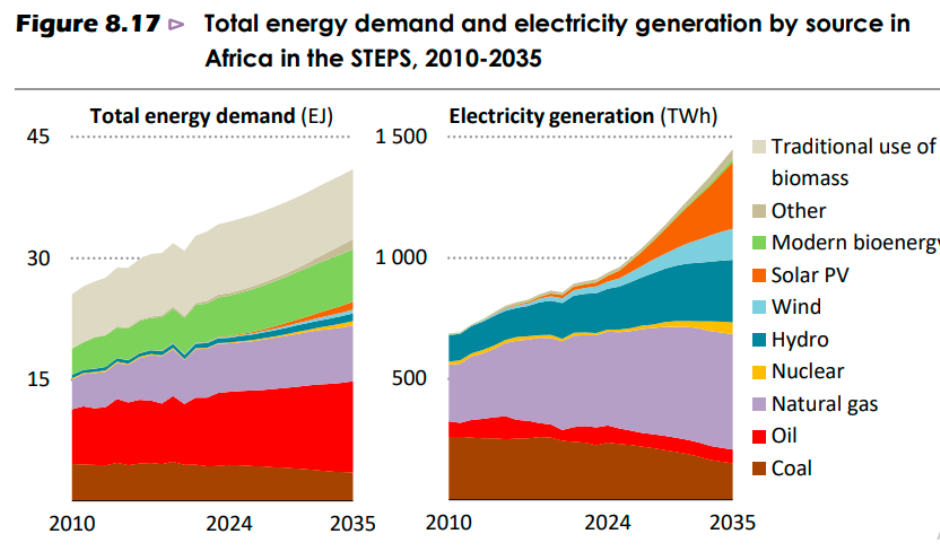The World Energy Outlook 2025 highlights Africa’s growing role in global energy transformation, focusing on domestic energy investment, renewable expansion, industrial development, and its emerging strength in critical mineral supply chains. Despite progress, challenges remain in achieving universal access and unlocking the continent’s vast potential. Here are ten key takeaways from the IEA report on Africa’s energy future through 2035.
1. Energy Investment Rebounds but Remains Below Requirements
Total energy investment in Africa is recovering after years of stagnation, approaching levels last seen in 2015. However, even with steady growth in the Stated Policies Scenario (STEPS), investments still fall short of what is needed to meet basic energy access and climate goals.
2. Accelerated Progress Toward Universal Energy Access
New national policies since 2024 have boosted efforts to expand modern energy access. By 2035, around 24 million people per year gain access to clean cooking and 20 million gain electricity connections—25 percent faster than the previous decade’s rate.
3. Clean Cooking Access Driven by LPG Growth
Liquefied petroleum gas (LPG) is projected to play a leading role in clean cooking access, with demand expected to rise by 150 thousand barrels per day by 2035. LPG expansion will remain central to addressing household energy poverty across sub-Saharan Africa.
4. Renewable Energy Dominates New Power Capacity
Africa will add an average of 24 GW of new power capacity annually through 2035— double the pace of the past decade. Over 70 percent of new capacity will come from renewables, with solar PV accounting for half due to cost competitiveness and abundant supply from China.
5. Solar PV to Overtake Hydropower by 2035
Solar PV is set to surpass hydropower as Africa’s second-largest source of electricity generation by 2035. Meanwhile, natural gas remains the largest power source, ensuring grid reliability, while nuclear power gains traction with Egypt’s El Dabaa plant expected to reach full capacity by 2030.
6. Expanding Power Grids to Meet Rising Demand
To support growing electricity consumption, Africa’s power networks will expand by an average of 190,000 kilometers each year to 2035—a 40 percent increase over current grid levels. This expansion is essential for connecting new renewable capacity and improving regional integration.
7. Oil and Gas Production Remains Stable
Oil production in Africa will remain steady through 2035, maintaining a 7–8 percent share of global output. Natural gas production rises modestly from 240 bcm in 2024 to around 260 bcm in 2035, led by new offshore LNG projects in Mozambique and continued contributions from Algeria, Egypt, and Nigeria.
8. Africa’s Strategic Role in Global Mineral Supply
Africa holds a dominant share of global reserves for key minerals—80 percent of platinum-group metals, 55 percent of cobalt and chromium, and 25 percent of manganese, bauxite, and graphite. These resources are vital for energy technologies such as batteries, solar panels, and wind turbines.
9. Moving Up the Mineral Value Chain
To capture more economic value, African nations are pursuing local processing of minerals rather than exporting raw ores. Countries like Zimbabwe and Gabon have introduced export restrictions to promote domestic refining, while Zambia and the DRC are developing processing for copper and cobalt.
10. Huge Potential to Boost Industrial Value and Jobs
If Africa scales refining and processing of key minerals, the total market value could rise from USD 70 billion in 2024 to USD 120 billion by 2040. This growth could drive industrialisation, create skilled jobs, and enhance economic resilience while supporting the global clean energy transition.
Conclusion
Africa’s energy outlook reflects both challenges and vast opportunities. With increased investment in renewables, power grids, and mineral processing, the continent can strengthen energy access, boost economic growth, and play a central role in the world’s transition to sustainable energy systems.
Baburajan Kizhakedath

